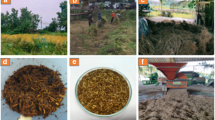Abstract
Today, the energy crisis, increasing emissions, and global warming have been crucial challenges in the world, especially in developing countries, and the use of renewable energies can be a good solution for these problems. Biogas is a renewable energy that has numerous benefits, including the production of fertilizers, increasing public health, control of diseases, and especially the production of clean energy. Therefore, methane production from weeds can be an attractive method to supply renewable fuel. The present study aimed to evaluate the potential of producing biogas from two new desert weeds, Sophora alopecuroides and Alhagi maurorum, on a lab-scale in four 2.4 L digestion tanks at room temperature (33 ± 2 °C) in two stages. Also, the effects of various parameters such as pH and different biomass:water ratios on methane production have been investigated. The produced gas compositions were analyzed using gas chromatography-thermal conductivity detector (GC-TCD). The quantities of biogas produced from both plants were determined at different biomass to water ratios and finally, the optimal ratio for each plant was determined. The quantity of optimal cumulative biogas production in 10 days was 2324 and 3099 ml for A. maurorum (biomass:water ratio = 1:5) and S. alopecuroides (biomass:water ratio = 1:6), respectively. The results proved that S. alopecuroides produced 33.34% more biogas compared to A. maurorum. The presence of high volatile solids and low dry solids, and higher carbon:nitrogen ratio (three times) in A. maurorum compared to S. alopecuroides are the effective factors in the production of the lower amount of biogas in this plant.











Similar content being viewed by others
Abbreviations
- SA:
-
Sophora alopecuroides
- AM:
-
Alhagi maurorum
- MC:
-
Moisture content
- TS:
-
Total solid
- VS:
-
Volatile solids
- B/W:
-
Biomass to water ratio
- H:
-
Hydrogen
- N:
-
Nitrogen
- C:
-
Carbon
- S:
-
Sulfur
- C/N:
-
Carbon to nitrogen ratio
References
Deymi-Dashtebayaz M, Dadpour D, Khadem J (2021) Using the potential of energy losses in gas pressure reduction stations for producing power and fresh water. Desalination 497:114763
Hekmatshoar M, Deymi-Dashtebayaz M, Gholizadeh M, Dadpour D, Delpisheh M (2022) Thermoeconomic analysis and optimization of a geothermal-driven multi-generation system producing power, freshwater, and hydrogen. Energy 247:123434
Dadpour D, Lakzian E, Gholizadeh M, Ding H, Han X (2022) Numerical modeling of droplets injection in the secondary flow of the wet steam ejector in the refrigeration cycle. Int J Refrig 136:103–113
Shahzad MW, Burhan M, Ang L, Ng KC (2017) Energy-water-environment nexus underpinning future desalination sustainability. Desalination 413:52–64
Chen L, Msigwa G, Yang M, Osman AI, Fawzy S, Rooney DW, Yap PS (2022) Strategies to achieve a carbon neutral society: a review. Environ Chem Lett:1–34
Deymi-Dashtebayaz M, Rezapour M, Farahnak M (2022) Modeling of a novel nanofluid-based concentrated photovoltaic thermal system coupled with a heat pump cycle (CPVT-HP). Appl Therm Eng 201:117765
Tayyeban E, Deymi-Dashtebayaz M, Dadpour D (2022) Multi objective optimization of MSF and MSF-TVC desalination systems with using the surplus low-pressure steam (an energy, exergy and economic analysis). Comput Chem Eng 160:107708
Faaij AP (2018) Securing sustainable resource availability of biomass for energy applications in Europe; review of recent literature. Hg. v. University of Groningen
Emebu S, Pecha J, Janáčová D (2022) Review on anaerobic digestion models: Model classification & elaboration of process phenomena. Renew Sust Energ Rev 160:112288
Ali S, Shafique O, Mahmood S, Mahmood T, Khan BA, Ahmad I (2020) Biofuels production from weed biomass using nanocatalyst technology. Biomass Bioenergy 139:105595
Ma X, Yu M, Yang M, Gao M, Wu C, Wang Q (2019) Synergistic effect from anaerobic co-digestion of food waste and Sophora flavescens residues at different co-substrate ratios. Environ Sci Pollut Res 26(36):37114–37124
Kusmayadi A, Lu P-H, Huang C-Y, Leong YK, Yen H-W, Chang J-S (2022) Integrating anaerobic digestion and microalgae cultivation for dairy wastewater treatment and potential biochemicals production from the harvested microalgal biomass. Chemosphere 291:133057
Tayyeban E, Deymi-Dashtebayaz M, Gholizadeh M (2021) Investigation of a new heat recovery system for simultaneously producing power, cooling and distillate water. Energy 229:120775
Saratale GD, Saratale RG, Banu JR, Chang J-S (2019) Biohydrogen production from renewable biomass resources. Biohydrogen (Second Edition):247–277
Abubackar HN, Keskin T, Yazgin O, Gunay B, Arslan K, Azbar N (2019) Biohydrogen production from autoclaved fruit and vegetable wastes by dry fermentation under thermophilic condition. Int J Hydrog Energy 44(34):18776–18784
Tursi A (2019) A review on biomass: importance, chemistry, classification, and conversion. Biofuel Res J 6(2):962–979
Eshore S, Mondal C, Das A (2017) Production of biogas from treated sugarcane bagasse. Int J Sci Eng Technol 6(7):224–227
Yan Q, Wang Y, Rodiahwati W, Spiess A, Modigell M (2017) Alkaline-assisted screw press pretreatment affecting enzymatic hydrolysis of wheat straw. Bioprocess Biosyst Eng 40(2):221–229
Akinshina N, Azizov A, Karasyova T, Klose E (2016) On the issue of halophytes as energy plants in saline environment. Biomass Bioenergy 91:306–311
Sinha D, Banerjee S, Mandal S, Basu A, Banerjee A, Balachandran S, Mandal NC, Chaudhury S (2021) Enhanced biogas production from Lantana camara via bioaugmentation of cellulolytic bacteria. Bioresour Technol 340:125652
Jomnonkhaow U, Sittijunda S, Reungsang A (2021) Influences of size reduction, hydration, and thermal-assisted hydration pretreatment to increase the biogas production from Napier grass and Napier silage. Bioresour Technol 331:125034
Li Y, Park SY, Zhu J (2011) Solid-state anaerobic digestion for methane production from organic waste. Renew Sust Energ Rev 15(1):821–826
Turcios AE, Weichgrebe D, Papenbrock J (2016) Potential use of the facultative halophyte Chenopodium quinoa Willd. as substrate for biogas production cultivated with different concentrations of sodium chloride under hydroponic conditions. Bioresour Technol 203:272–279
Ahn HK, Smith M, Kondrad S, White J (2010) Evaluation of biogas production potential by dry anaerobic digestion of switchgrass–animal manure mixtures. Appl Biochem Biotechnol 160(4):965–975
Xi Y, Liu Y, Ye X, Du J, Kong X, Guo D, Xiao Q (2021) Enhanced anaerobic biogas production from wheat straw by herbal-extraction process residues supplementation. Front Bioeng Biotechnol 9:281
André L, Zdanevitch I, Pineau C, Lencauchez J, Damiano A, Pauss A, Ribeiro T (2019) Dry anaerobic co-digestion of roadside grass and cattle manure at a 60 L batch pilot scale. Bioresour Technol 289:121737
Zhao W, Yang H, He S, Zhao Q, Wei L (2021) A review of biochar in anaerobic digestion to improve biogas production: performances, mechanisms and economic assessments. Bioresour Technol 341:125797
Liu T, Miao P, Shi Y, Tang KH, Yap PS (2022) Recent advances, current issues and future prospects of bioenergy production: a review. Sci Total Environ 810:152181
Schallberger J, Oka L (2022) Investigating the effect of direction of grass roots on shear strength of soil and stability of embankment slope. In: Advances in Transportation Geotechnics IV. Springer, pp 595–606
Qiao W, Yan X, Ye J, Sun Y, Wang W, Zhang Z (2011) Evaluation of biogas production from different biomass wastes with/without hydrothermal pretreatment. Renew Energy 36(12):3313–3318
Samani Majd S, Abdoli MA, Karbassi A, Pourzamani HR, Rezaee M (2017) Effect of physical and chemical operating parameters on anaerobic digestion of manure and biogas production: a review. J Environ Health Sustain Dev 2(1):235–247
Horiuchi J-I, Shimizu T, Tada K, Kanno T, Kobayashi M (2002) Selective production of organic acids in anaerobic acid reactor by pH control. Bioresour Technol 82(3):209–213
Głowacka A, Szostak B, Klebaniuk R (2020) Effect of biogas digestate and mineral fertilisation on the soil properties and yield and nutritional value of switchgrass forage. Agronomy 10(4):490
Funding
The study was funded by Hakim Sabzevari University (HSU).
Author information
Authors and Affiliations
Contributions
Mohammad Gholizadeh: conceptualization, writing–reviewing and editing
Mahdi Deymi-Dashtebayaz: conceptualization, writing–reviewing and editing, supervision
Abolfazl Mehri: data curation, software, writing–original draft preparation
Alireza Zameli: writing–original draft preparation, writing–original draft preparation
Daryoush Dadpour: writing–reviewing and editing
Corresponding authors
Ethics declarations
Conflict of interest
The authors declare no competing interests.
Additional information
Publisher’s note
Springer Nature remains neutral with regard to jurisdictional claims in published maps and institutional affiliations.
Rights and permissions
About this article
Cite this article
Gholizadeh, M., Deymi-Dashtebayaz, M., Mehri, A. et al. Experimental evaluation and optimization of the anaerobic digestibility of two new desert weeds for biogas production. Biomass Conv. Bioref. 14, 8395–8405 (2024). https://doi.org/10.1007/s13399-022-02884-5
Received:
Revised:
Accepted:
Published:
Issue Date:
DOI: https://doi.org/10.1007/s13399-022-02884-5




